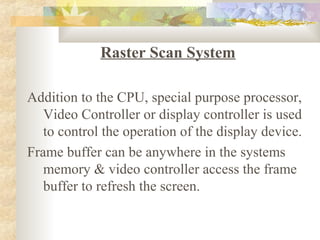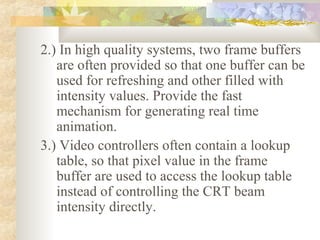Raster scan system
- 1. Raster Scan System Addition to the CPU, special purpose processor, Video Controller or display controller is used to control the operation of the display device. Frame buffer can be anywhere in the systems memory & video controller access the frame buffer to refresh the screen.
- 2. System Video Monitor CPU Memory Controller System Bus I/O Devices Raster Graphics System
- 3. Fixed Portion of the system memory is reserved. Frame buffer locations, and the corresponding screen Positions are referenced in Cartesian Coordinates. System Frame Video CPU Monitor Memory Buffer Controller System bus I/O Device
- 4. Refresh Operation in Video controller Raster-Scan Horizontal & Vertical Generator Deflection Voltage X Y Register Register Pixel Register Intensity Memory Address Frame Buffer
- 5. The multiple pixel intensities are then stored in a separate register and used to control the CRT beam intensity for a group of adjacent pixels. Other Operations performed by Video Controller are: 1.) It can retrieve pixel intensities from different memory areas on different cycles
- 6. 2.) In high quality systems, two frame buffers are often provided so that one buffer can be used for refreshing and other filled with intensity values. Provide the fast mechanism for generating real time animation. 3.) Video controllers often contain a lookup table, so that pixel value in the frame buffer are used to access the lookup table instead of controlling the CRT beam intensity directly.
- 7. Raster Scan display Processor Sometimes also referred as graphics controller or a display coprocessor and its purpose is to free the CPU from the graphics operations. For this separate display processor memory area is also provided. Its major task is to digitize a picture definition given in an application program into a set of pixel intensity values for storage in a frame buffer.
- 8. This digitization process is called scan-conversion. Graphics commands specifying straight lines and other geometric objects are scan converted into a set of discrete intensity points. Scan converting a straight line means, we have to locate the pixel positions closest to the line path and store the intensity for each position in the frame buffer.
- 9. Raster Graphic system with Display processor Display- Frame Video Processor Monitor Buffer Controller Memory CPU Display System Processor Memory System Bus I/O Device
- 10. Raster Graphic system with Display processor Display- Frame Video Processor Monitor Buffer Controller Memory CPU Display System Processor Memory System Bus I/O Device










